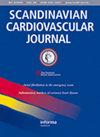新冠肺炎死亡患者心脏无组织性心肌炎的形态学变化
IF 1.2
4区 医学
Q3 CARDIAC & CARDIOVASCULAR SYSTEMS
引用次数: 1
摘要
摘要目的。患有潜在心脏病的患者死于Covid-19的风险更高。也有人认为,Covid-19通过心肌炎影响心脏。尽管对Covid-19相关并发症管理的研究迅速增加,但大多数正在进行的研究都集中在Covid-19的呼吸道并发症上,而对心肌炎的患病率知之甚少。设计。本研究旨在通过使用一组抗体来检测Covid-19死亡患者尸检过程中获得的心脏组织中的缺氧和炎症变化以及SARS-CoV-2蛋白的存在,来表征心肌受累情况。37例COVID-19死亡病例和21例对照纳入本研究。结果。总体而言,Covid-19心脏有几种组织病理学变化,如肌细胞波浪形、纤维化、收缩带坏死、多形核中性粒细胞浸润、空泡化和肌细胞坏死。此外,在心脏组织中检测到内皮损伤和活化。然而,使用RNA原位杂交无法检测到病毒复制。此外,作为心肌炎标志的淋巴细胞浸润在本研究中未见。结论。所有病例均未发现心肌炎的组织学征象;因此,我们的发现与存在循环内皮激活因子(如VEGF)的假设最为一致,该因子起源于心脏外,可能来自Covid-19肺部的缺氧部分。本文章由计算机程序翻译,如有差异,请以英文原文为准。
Morphological changes without histological myocarditis in hearts of COVID-19 deceased patients
Abstract Objective. Patients with underlying heart diseases have a higher risk of dying from Covid-19. It has also been suggested that Covid-19 affects the heart through myocarditis. Despite the rapidly growing research on the management of Covid-19 associated complications, most of the ongoing research is focused on the respiratory complications of Covid-19, and little is known about the prevalence of myocarditis. Design. This study aimed to characterize myocardial involvement by using a panel of antibodies to detect hypoxic and inflammatory changes and the presence of SARS-CoV-2 proteins in heart tissues obtained during the autopsy procedure of Covid-19 deceased patients. Thirty-seven fatal COVID-19 cases and 21 controls were included in this study. Results. Overall, the Covid-19 hearts had several histopathological changes like the waviness of myocytes, fibrosis, contract band necrosis, infiltration of polymorphonuclear neutrophils, vacuolization, and necrosis of myocytes. In addition, endothelial damage and activation were detected in heart tissue. However, viral replication was not detected using RNA in situ hybridization. Also, lymphocyte infiltration, as a hallmark of myocarditis, was not seen in this study. Conclusion. No histological sign of myocarditis was detected in any of our cases; our findings are thus most congruent with the hypothesis of the presence of a circulating endothelium activating factor such as VEGF, originating outside of the heart, probably from the hypoxic part of the Covid-19 lungs.
求助全文
通过发布文献求助,成功后即可免费获取论文全文。
去求助
来源期刊

Scandinavian Cardiovascular Journal
医学-心血管系统
CiteScore
3.40
自引率
0.00%
发文量
56
审稿时长
6-12 weeks
期刊介绍:
The principal aim of Scandinavian Cardiovascular Journal is to promote cardiovascular research that crosses the borders between disciplines. The journal is a forum for the entire field of cardiovascular research, basic and clinical including:
• Cardiology - Interventional and non-invasive
• Cardiovascular epidemiology
• Cardiovascular anaesthesia and intensive care
• Cardiovascular surgery
• Cardiovascular radiology
• Clinical physiology
• Transplantation of thoracic organs
 求助内容:
求助内容: 应助结果提醒方式:
应助结果提醒方式:


